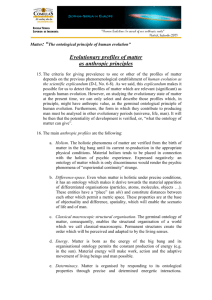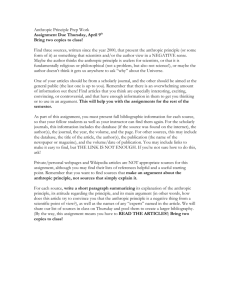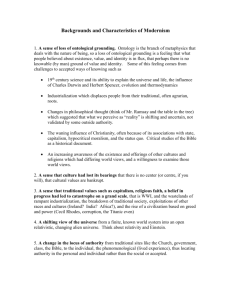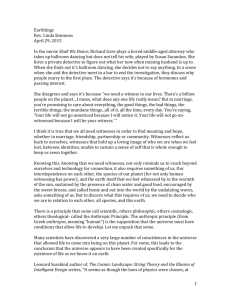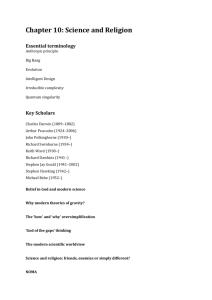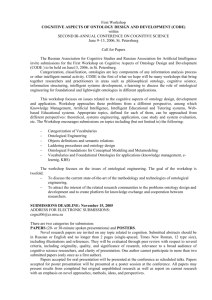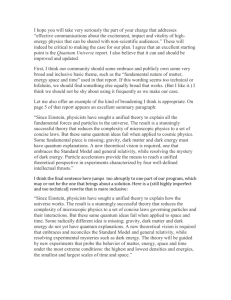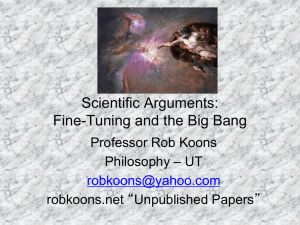Summary
advertisement
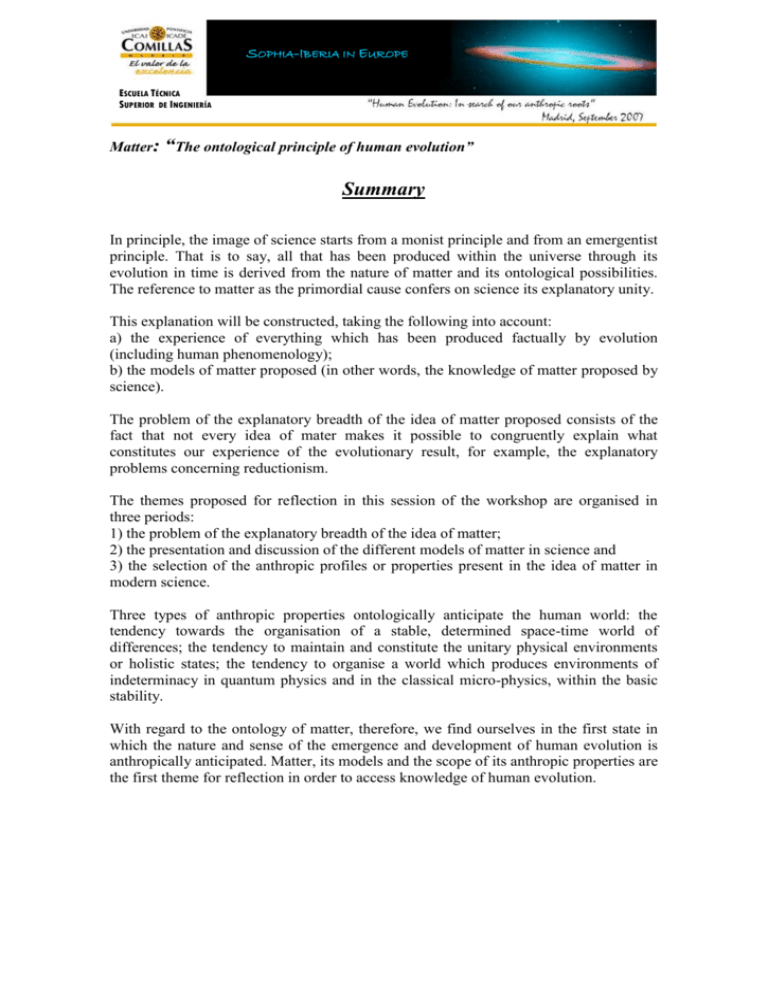
SOPHIA-IBERIA IN EUROPE ESCUELA TÉCNICA SUPERIOR DE INGENIERÍA Matter: “The ontological principle of human evolution” Summary In principle, the image of science starts from a monist principle and from an emergentist principle. That is to say, all that has been produced within the universe through its evolution in time is derived from the nature of matter and its ontological possibilities. The reference to matter as the primordial cause confers on science its explanatory unity. This explanation will be constructed, taking the following into account: a) the experience of everything which has been produced factually by evolution (including human phenomenology); b) the models of matter proposed (in other words, the knowledge of matter proposed by science). The problem of the explanatory breadth of the idea of matter proposed consists of the fact that not every idea of mater makes it possible to congruently explain what constitutes our experience of the evolutionary result, for example, the explanatory problems concerning reductionism. The themes proposed for reflection in this session of the workshop are organised in three periods: 1) the problem of the explanatory breadth of the idea of matter; 2) the presentation and discussion of the different models of matter in science and 3) the selection of the anthropic profiles or properties present in the idea of matter in modern science. Three types of anthropic properties ontologically anticipate the human world: the tendency towards the organisation of a stable, determined space-time world of differences; the tendency to maintain and constitute the unitary physical environments or holistic states; the tendency to organise a world which produces environments of indeterminacy in quantum physics and in the classical micro-physics, within the basic stability. With regard to the ontology of matter, therefore, we find ourselves in the first state in which the nature and sense of the emergence and development of human evolution is anthropically anticipated. Matter, its models and the scope of its anthropic properties are the first theme for reflection in order to access knowledge of human evolution. Objectives, criteria and methods 1. Matter and universe evolutionally move together: the universe is born as an evolutionary organisation of matter which responds to the real ontology of this matter. The knowledge of matter and the universe is almost inseparable. In the workshop, it was decided to first reflect on the universe, but in the conviction that these are themes which are inseparable in many senses. 2. We ask what the image of matter in present day science is. We refer to the first evolutionary state selected (see: D-I) in order to understand the scientific image of human evolution. Our intention is also that this image takes us forward to responding to the final question on the theology which this scientific image of human evolution leads to, if it leads to a theology at all. The first response to the question on matter is the usual work hypothesis which seems to constitute a generalised expectation of science: matter is the ontological principle which produces the universe (and all its content, including life and man). Ontological means that the reality and being of matter, with its variety of properties, is the potential principle of evolution of the universe, life and man. Due to this expectation, we say that science in principle moves in a supposed, hypothetical monist principle. 3. The scientific image of matter in the monist principle must also be complemented with another principle: matter is the principle of emergence of a substantial variety of forms of reality and of their evolutionary production in the universe, in life and in man. Therefore, the emergentist principle is formulated in the hypothetical case of its harmony with the monist principle. 4. The emergentist principle makes it possible to understand obvious scientific reasoning. a) What are verified ontologically are the facts which arise in the universe and their factuality cannot be placed in doubt. b) Therefore, in accordance with the suppositions of the monist principle and of the emergentist principle, matter must be the potential principle of what is produced in the universe. c) If our image of matter does not make it possible to understand it as a potential principle of these facts, then only one of these two alternatives can be accepted: our image of matter is incorrect, or we must negate the monist principle (in other words, besides matter, there must be other ontological principles which contribute to explaining the nature of certain facts occurring in the universe, such as life or man, which are not explicable by the monist approach). 5. The supposition that matter must have the properties required to make man possible is expressed in the form of a new anthropic principle. This principle formulates the evidence that man is a fact produced from matter and, therefore, matter must be attributed to the properties required and sufficient for this. This is a “weak” formulation of an anthropic principle which does not suppose a philosophical thesis on a probable or not probable intelligent design. The idea of matter and the problem of its explanatory breadth 6. We have said that science moves within the hypothesis that the universe is explained from a primordial sub-stratum from which everything is produced. This sub-stratum is given the name “matter”. However, this supposition does not include a precise idea or knowledge of this sub-stratum or, in other words, of what matter in itself is. In fact, the ideas on matter have varied throughout history, but especially in the evolution of physics in the last 150 years. 7. Consequently, the explanatory capacity of matter (to explain all the factual phenomena of the universe which, supposedly, should have been produced from matter) obviously depends on the idea of matter which is proposed. The scientific explanation is that the explanatory capacity is total (no phenomena produced in the universe can be excluded). If this were only partial, the reasoning explained in point 4 would be applied, or the supposed idea of matter should be rejected, or the monist and emergentist principles would be rejected. 8. From a historical perspective, we see that science has not always had (and does not have at the present time) this pretension to offer a total explanation. The classical mechanics of Newton, for example, intended to show an idea of matter which might explain “the physical world of immediate phenomenal experience”. This continues to be the approach of quite a number of present day systems of physics. 9. On occasions, an idea of matter is constructed based on the pure, external, physical world, but, it also attempts to have a total explanatory capacity (the physical world, but also life and man in his psychic, phenomenological aspects). In order to have a total explanation, the idea of matter as a supposition to explain the totality of phenomena is forced and overvalued. This “explanatory violence” is known in the history of the philosophy of science as reductionism. 10. Occasionally scientists and philosophers have renounced a total explanation in accordance with monist and emergentist principles. In this case, they have postulated the existence of two explanatory causal principles (co-principles), which are ontologically different insofar as they cannot be equated (one could not have generated the other through evolution). History shows the two types of dualism which most influenced western thought: first the Platonic-AristotelianScholastic dualism (except for nuances) and the Cartesian dualism. Dualism breaks the explanatory unity of the universe. 11. Consequently, the study of the primordial evolutionary state, matter from the focus of human evolution (the proposed focus of the workshop) supposes that attention is given to two complementary themes. First, the different ontological models of matter since each present different explanatory capacities. Second, the relevant evolutionary profiles which must be valued in the models of matter in order to understand in which sense the evolutionary state of matter has an anthropic design, a nature which makes it explicable a radice why and how the subsequent evolution of matter could make man possible. Not any idea of matter would have been anthropic (for example, it is doubtful whether the “reductionist image” is). However, the fact that man (and previous life) exist obliges us to have an anthropic idea, if we wish to maintain the unitary monist congruence as regards the explanation of the world. The criteria for selecting one or other evolutionary profiles in matter in order to pre-judge its anthropic potentiality, has already been explained in D-I (see: Human evolution as a phenomenological explicandum, D-I, No. 6-8). Knowing the properties of human evolution at the present time through phenomenology, in fact, provides us with a heuristic criterion in order to select features of the anthropic ontology of matter. 12. Below we refer to these two themes: first, the models of matter; second, the relevant evolutionary profiles in the ontology of matter as regards human evolution. Ontological models of matter 13. Throughout history, the ontological idea of matter has responded to differentiated models which lead to several consequent analyses of the evolutionary profiles which link with human evolution. a. Matter in classical mechanics: the corpuscular model. Classical mechanics predicts the physical evolution of a system from determinist laws when certain initial conditions are supposed. Are physical laws determinists in themselves? Is it necessary to know all the initial conditions to predict its evolution? How can the precision of its predictions be explained? How would determinism be seen from the quantum idea of fermionic matter? What role does determinism play in creating a stable, differentiated world, apt for life (differentiation and inheritance)? Mathematical discontinuity and classical mechanics. b. Radiation in classical mechanics: field models. The field effects of matter provoked a re-definition of classical physics in terms of classical electro-dynamic and gravitational fields. Is classical determinism compatible with classical determinism with the number of degrees of freedom of the continuous fields? Is determinism compatible with relativity? c. Quantum model: unity-duality corpuscle-wave. The Newtonian thesis of corpuscles and the wave antithesis of Huygens were synthesised with the quantum principle of wave-corpuscle. Is this a dualist principle? On the contrary, is there a monist synthesis of different emergent properties of matter? What does this say about the continuity of matter? d. Mechanical-quantum matter: ontological models. The physics of elementary particles has scrutinised matter as far as sub-nuclear atomic levels dominated by quantum fields. What is understood by fundamental particle? Is there an ultimate material sub-stratum? Is it possible to conceive matter without interaction? What is the final ontology of spacetime? Is it ether, the energy field, the quantum vacuum …? What is the ontology of “indeterminism” in quantum physics? Can quantum states produce indeterminate events? e. Mechanical-quantum matter: the Copenhagen model. Niels Bohr created an epistemology of quantum theory with no possibility of interpreting physics beyond the experimental result at a given time. Is an epiphenomenon everything which is not measured? Should research be carried out in accordance with the advice to shut up and calculate? Is the quantum physics of Copenhagen complete? f. Holistic matter in classical and quantum models. The gedankenexperiment of Einstein versus the Copenhagen model opened up new theoretical research into a non-local physical reality, which is the basis of the current teleportation technology. How is this non-local physical nature explained as fields? How can this contribute to understanding quantum coherence between quantum fields at a distance? g. Matter in the scale of Planck. At energy 1025 eV, matter loses all its definition in favour of a dynamic energy field. Space – time itself becomes indefinite. There are only quantum fluctuations of energy. Is it possible to maintain determinism at this level? How does corpuscular matter emerge? What produces the stability of matter? h. Speculation on matter: the Higgs, super-strings and multiple dimensions. Beyond the efficient but incomplete Standard Model, the theoreticians of particles search for a new model of matter. Is the field of Higgs the fundamental physical component? Is our material universe a threedimensional bubble in a multi-dimensional space? Will the Large Hadron Collider detect a super-string? 14. Not all these models have the same support in empirical evidence. In a way, they are complementary as regards empirical aspects of reality. The fact that these models can be construed by the human mind (even when there is still a lack of empirical evidence, as occurs with string theory) shows the open and critical, hypothetical, not closed and absolute character of the idea of matter in scientific knowledge. Evolutionary profiles of matter as anthropic principles 15. The criteria for giving prevalence to one or other of the profiles of matter depends on the previous phenomenological establishment of human evolution as the scientific explicandum (D-I, No. 6-8). As we said, this explicandum makes it possible for us to detect the profiles of matter which are relevant (significant) as regards human evolution. However, on studying the evolutionary state of matter at the present time, we can only select and describe those profiles which, in principle, might have anthropic value, as the germinal ontological principle of human evolution. Furthermore, the form in which they contribute to producing man must be analysed in other evolutionary periods (universe, life, man). It will be then that the potentiality of development is verified, or, “what the ontology of matter can give”. 16. The main anthropic profiles are the following: a. Holism. The holistic phenomena of matter are verified from the birth of matter in the big bang until its current re-production in the appropriate physical conditions. Material holism tends to be placed in connection with the holism of psychic experience. Expressed negatively: an ontology of matter which is only discontinuous would render the psychic phenomena of “experiential continuity” strange. b. Difference-space. Even when matter is holistic under precise conditions, it has an ontology which makes it derive towards the material apparition of differentiated organisations (particles, atoms, molecules, objects …). These entities have a “place” (an ubi) and constitute distances between each other which permit a metric space. These properties are at the base of objectuality and difference, spatiality, which will enable the scenario of life and of man. c. Classical macroscopic structural organisation. The germinal ontology of matter, consequently, enables the structural organisation of a world which we call classical-macroscopic. Permanent structures create the order which will be perceived and adapted to by the living senses. d. Energy. Matter is born as the energy of the big bang and its organisational ontology permits the constant production of energy (e.g. in the sun). Material energy will make work, action and the adaptive movement of living beings and man possible. e. Determinacy. Matter is organised by responding to its ontological properties through precise and determined energetic interactions. Determinacy is the principle of order and security which makes life possible. f. Stability-legality. Matter creates a stable system determined by laws as a consequence of the determinist properties of material ontology. The determinist laws create the stability to support the form of the universe and the stability of biological inheritance. g. Change-time. In a balanced fashion, the ontology of matter creates an energetic system of changes and the transformation its states which create a time system (evolutionary) which makes space a space-time. This seems to connect with the temporal history of human life as an ontological material base. h. Indeterminacy. Determinist ontology of matter permits environments of indeterminacy in a balanced fashion where future states which evolve in energetic change and which can occur or not occur. These “ontological loops of indeterminacy” would offer the ontological possibility for spontaneous self-determination of life, and man in order to choose their “own evolution routes”. i. Chaotic interaction. The chaotic interaction of matter opens up a new perspective in order to insist on an indeterminist model of matter which offers the image of ontology for “living indeterminacy”. j. Probability. The evolutionary states generated from material interactions open up a probabilistic future which is configured within a framework of determinacy. Material systems tending towards probabilities or “propensities” are more congruent with the subsequent evolution of life. k. Creativity. According to this, the theory of matter shows us its energetic change of state in time as a creative process (in the sense of the configuration of possibilities which are not necessary in time). Living beings could have appropriated this creative ontology of matter. 17. As a whole, the models of matter in science (see above: No. 13) present these profiles, but not necessarily, nor in the same form, in all of these. Therefore, the study of matter from an anthropic perspective must involve an in depth contribution and valuation of the models. Discussion Reductionist models Do the reductionist models make sense? Do they have epistemological justification as regards the construction of an image of matter? Does this necessary inter-disciplinary factor of science make it necessary to construct models of matter valued from a global phenomenology of the universe and its variety of content? – History and analysis of reductionist science and its current presence and epistemological valuation or criteria. Anthropic models Is it epistemologically justified to demand that science construct explanations which are “anthropically” congruent in its different stages? What role has the anthropic played in the history of the physics of matter? Which authors have contributed to an “anthropic science” (Bergson, Whitehead, Teilhard, etc.)? Which hypotheses have they proposed? Is our proposal of anthropic profiles in the physics of matter correct? Must it be added to? Does it have alternatives? Corpuscularity Corpuscularity and reductionism. To what point is corpuscularity admissible in physics? Corpuscularity and discontinuity. Is corpuscularity-discontinuity “anthropic”? Its role in the evolutionary formation of the classical macroscopic world of differences. A physics balanced between corpuscularity-discontinuity and the field-waveness-continuity. Holism The history of holistic ideas in the physics of matter. Holism in classical mechanics. Material matter in the idea of radiation in the XIX century. Holistic phenomena in quantum mechanics. Holistic phenomena in current physics. The anthropic character of holistic phenomena. Determinacy-indeterminacy The ontological properties of matter lead to a balance between determinacy and indeterminacy. Why is the ontology of matter determinist? Why does a determinist system produce environments of indeterminacy? Can determinacy and indeterminacy be harmonised? Which type of ontology, epistemological or ontological? The balance between determinacy –indeterminacy as an anthropic property of matter. Is determinacy reductionist? Continuity-discontinuity There are models of matter which lead to discontinuity; others support continuity. Conceptual problems (mathematical, scientific, philosophical) concerning continuitydiscontinuity. Their relationship with holism of matter and the theory of fields. Stability-change -energy Matter produces stable beings from resources of energy united to matter from the big bang, which are subjected to change. These material principles seem to play a very important role in the organised form of then universe and in the conditions which make life possible. In what sense does this matter prefigure an anthropic universe? Difference-objectivity-subjectivity In some way, matter has produced a world of differences and this is the basis for beings becoming subjects and objects for each other. How and why did matter create a world of difference which prefigures the world of subjects and objects which will make life possible? Could the world have been different? Could a material world be possible with no outlines, like undifferentiated plasma?
